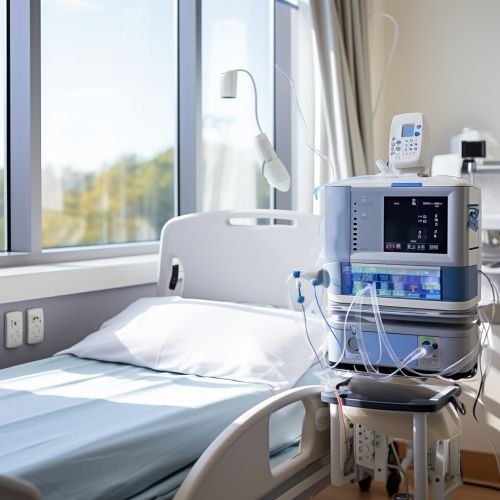Ventilator-associated pneumonia
Introduction
Ventilator-associated pneumonia (VAP) is a type of lung infection that occurs in people who are on mechanical ventilation breathing machines in hospitals. As the name suggests, VAP affects patients who are on a ventilator, a machine designed to assist or replace spontaneous breathing.


Pathophysiology
VAP occurs when bacteria invade the lower respiratory tract and lung parenchyma. This invasion is often facilitated by the endotracheal tube, which bypasses the body's natural defenses against bacteria, such as coughing and the mucociliary escalator. The bacteria can come from the patient's own mouth and throat (endogenous bacteria) or from the hospital environment (exogenous bacteria). The endotracheal tube also allows bacteria to form a biofilm, a community of bacteria that can be difficult to eradicate with antibiotics.
Risk Factors
There are several risk factors that increase the likelihood of developing VAP. These include prolonged mechanical ventilation, underlying lung disease, and severe illness. Other risk factors include malnutrition, immunosuppression, and prior antibiotic use. The use of certain medications, such as sedatives and muscle relaxants, can also increase the risk of VAP.
Diagnosis
The diagnosis of VAP can be challenging, as many of the symptoms are non-specific and can be seen in other conditions. These symptoms may include fever, increased secretions, changes in blood gases, and new or worsening infiltrates on chest x-ray. The gold standard for diagnosis is a bronchoalveolar lavage, which involves washing out the lungs with saline and then examining the fluid for bacteria.
Treatment
The treatment of VAP involves the use of antibiotics to kill the bacteria causing the pneumonia. The choice of antibiotic depends on the type of bacteria suspected or identified and the patient's other medical conditions. In addition to antibiotics, supportive care is also important. This may include oxygen therapy, physiotherapy, and nutrition support. In some cases, the ventilator settings may need to be adjusted to help clear secretions and improve lung function.
Prevention
Prevention of VAP involves a combination of measures to reduce the risk of bacterial contamination and to enhance the patient's defenses. These measures include good hand hygiene, oral care with chlorhexidine, elevation of the head of the bed, and regular assessment for the possibility of extubation. In addition, there are specific guidelines for the care of the ventilator and the endotracheal tube to prevent bacterial contamination.
Epidemiology
VAP is a common complication of mechanical ventilation, with studies suggesting that it affects between 10 and 20% of patients who are ventilated for more than 48 hours. VAP is associated with increased morbidity and mortality, longer hospital stays, and increased healthcare costs. The incidence of VAP varies widely between different hospitals and different intensive care units within the same hospital, suggesting that it is at least partly preventable.
